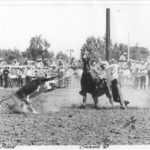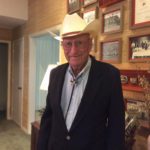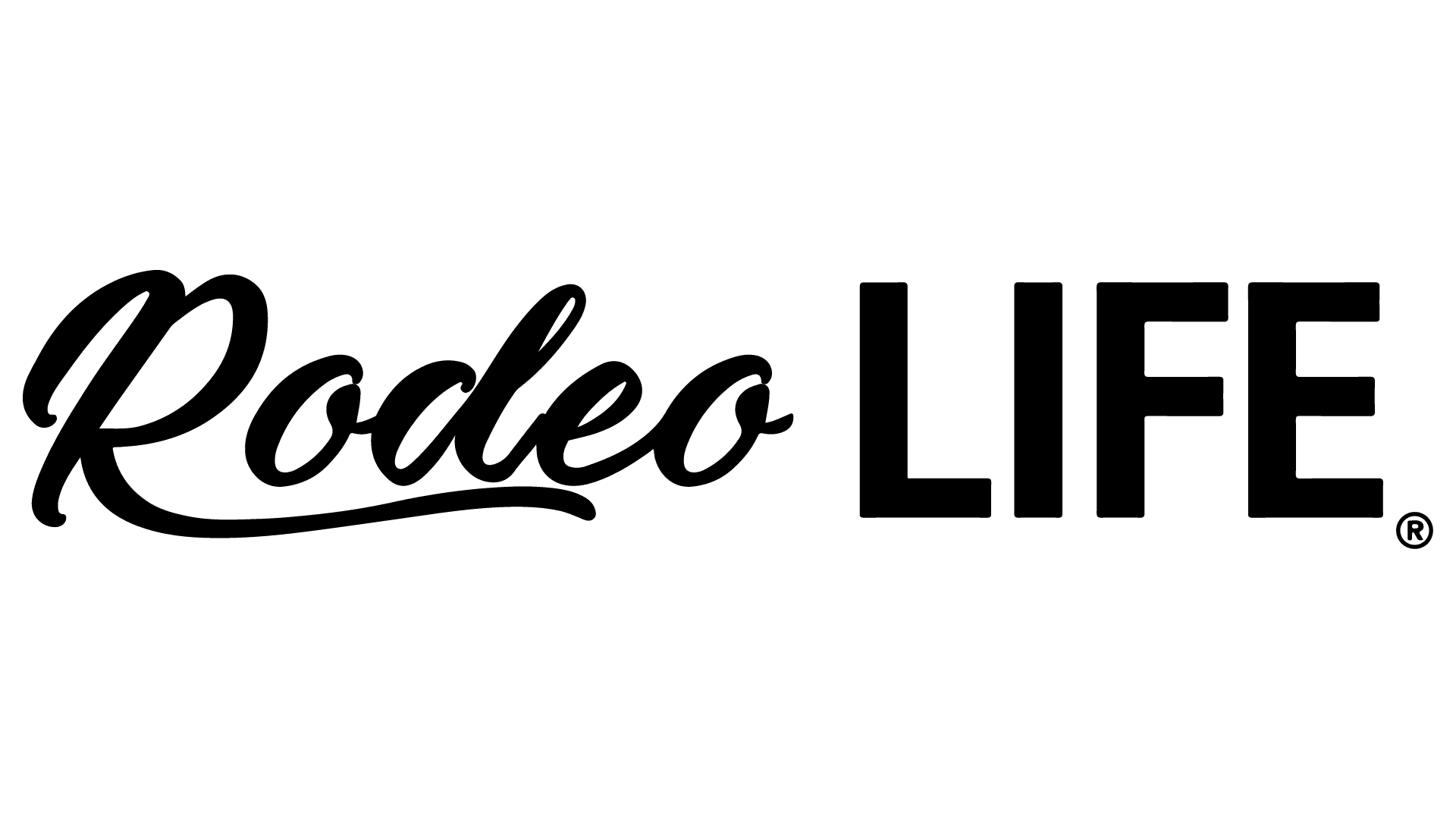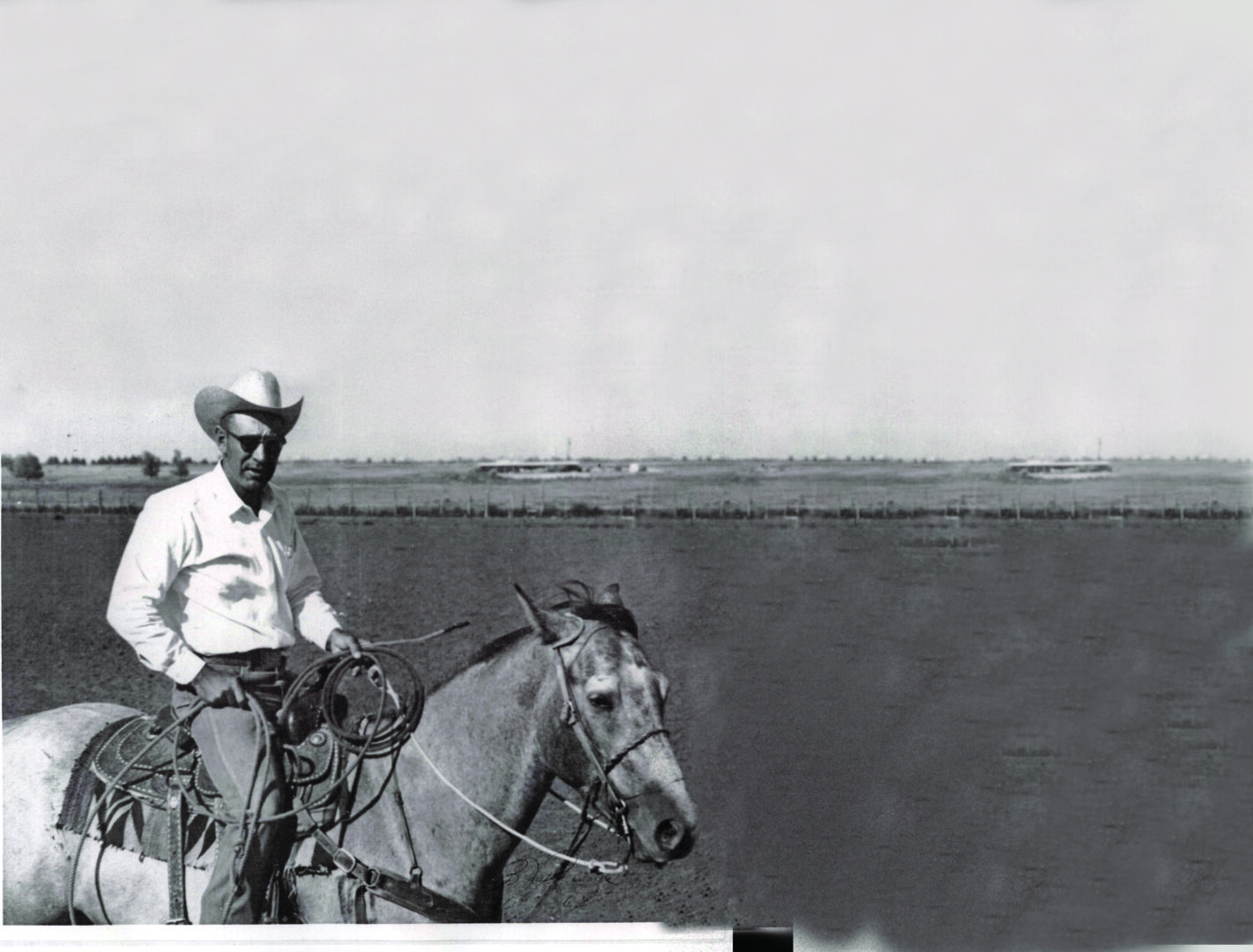story by Lily Weinacht
Born on August 22, 1926, to Grady and Dolores Pierce in Clovis, N.M., B.J. Pierce was fated to wear dirt on his boots, but always with pride – first as a farmer, and forever as a cowboy.
The Pierce family raised cattle and farmed in the shadow of the Dust Bowl, sleeping with rags on their faces and perpetually cleaning the Kansas dirt from their window sills. B.J. worked the fields alongside his parents, but his dad always left him the last few minutes of daylight to rope in the backyard. Inspired by the tales told by his grandfather, a cowboy from Oklahoma, B.J. was more passionate about roping than anything else. With high school and college rodeo yet to be created, he taught himself to rope calves, winning his first rodeo in Tucumcari, N.M. in 1945. After graduating high school the same year, B.J. met Shorty Matlock, a steer wrestler and fellow tie-down roper from Grady, N.M.
The two cowboys became travelling partners, and a summer full of roping boxes, rodeos, sleeping in horse trailers, and bathing in creeks earned B.J. enough money to pay for a year of college. The fall of 1945, he attended Eastern New Mexico University in Portales, studying for a degree in industrial arts and playing basketball on a scholarship. There, he met his first wife, Patty Rawls, whom he married in 1947. The following summer, B.J. and Shorty set out again, and B.J. won enough money to finish paying for his college tuition, as well as Patty’s. By his junior year of college, B.J. quit playing basketball, knowing his future was in the arena, not the basketball court. He graduated in 1950 and immediately began rodeoing full time, frequently announced as one of only two full-time rodeo cowboys in the region that had college degrees.
Though B.J. also competed in wild cow milking, team roping, and steer roping, tie-down roping was his main event. He even served on the RCA Board of Directors as the Calf Roping Director. He competed in the RCA and won the tie-down roping – often more than once – in rodeos across the Pacific West, including Pendleton, Ore., Ellensburg, Wash., and Lewiston and Nampa, Idaho. His truck and trailer traversed the U.S. even further, taking him to Denver, Colo., which he won in the tie-down roping, Cheyenne, Wyo., where he earned buckles on two separate occasions, and even as far as New York City and Calgary.
One of the single largest paychecks he earned came from a one day tie-down roping in Los Angeles. B.J. returned home with $2,500 riding comfortably in his wallet. Another favorite of his was the tie-down roping invitational held in his hometown of Clovis in 1952, where 17 of the world’s best ropers came to compete. B.J. and every other roper put up $500, and he left with $5,200. The furthest B.J. and Patty travelled, however, was Cuba. In the mid 1950s, Colonel Jim Eskew held a rodeo on the island, the rodeo livestock and contestants alike arriving on boats from Florida. B.J.’s own horse, Iodine, stayed in the U.S., and B.J. borrowed a horse to avoid putting Iodine in quarantine.
B.J. remembers Iodine as his best roping horse, winning his three world tie-down championships with the IRA on the gelding in 1952, ’53, and ’55. “He was very good to me,” B.J. recalls. “He went with me a long time, all over the U.S. He was featured on the cover of the Quarter Horse Journal in the early 1950s. Iodine’s daddy was Billy Clegg, and his foals were noted for becoming good cow horses.”
The thousands of miles B.J. racked up on his speedometer also left a trail of friends in many states, including world champion tie-down roper Dean Oliver from Idaho, who became one of B.J.’s close friends. Connections like these propelled B.J. into selling ads for Western Horseman. Patty wrote articles for the magazine while B.J. rodeoed in California, where they lived for five years. When the advertising position came open, B.J. filled it. “Since I’d been so many places rodeoing, people knew who I was. I got to go to big horse shows and meet people you’d never meet rodeoing, like Gene Autry, James Arness, and Miss Kitty (Amanda Blake). A lot of those people were in the horse business. The only negative thing was selling ads and people not paying for them,” B.J. remembers. “You just didn’t go back to them again!”
By the early 1960s, B.J. was ready to hang up his rope. “I guess I got tired!” he says. “All I did for 13 years was rodeo. So I retired from the rodeo business and started teaching school. I had a degree in secondary education, and I was going to teach one year in sixth grade. I ended up staying 31 years in the school system.” B.J. was a teacher for 16 of those 31 years before moving to administration and becoming a principal. He worked at several schools in Clovis, including Highland Elementary and James Bickley Elementary School. Having lived all but five years of his life in Clovis, B.J. still sees many of his former students. Ever the cowboy, B.J. brought the lessons he’d learned in the arena to the classroom, teaching discipline and organization.
In 1979, B.J., who was divorced, married his second wife, Sue. He had two children, Rena and Ben, and Sue had a son, John, while B.J. and Sue became the delighted grandparents of four grandchildren. They were married for 31 years until Sue passed away in 2008, and during much of that time, B.J. continued to teach, while training calf horses for ropers all over the region. He has also been a member of the Curry County Mounted Patrol for many years, serving as the organization’s captain, vice-president, secretary, and treasurer. The patrol was created in 1939 to promote horses, horsemanship, and sponsor western entertainment like rodeos and ropings. A lifetime member, B.J. continues to help put on the annual Pioneer Days PRCA rodeo in Clovis. At 89, riding has lost none of its charm, and B.J. still takes his horses up to the mountains to ride. “It’s fun if you don’t fall off!” he adds wryly.
Recently inducted into the National Cowboy and Western Heritage Museum’s Rodeo Hall of Fame, B.J. also attended the 100th anniversary of the Pendleton Round-Up as a guest of honor in 2010. Visiting today’s rodeos brings back many recollections of his own rodeo years. “The cattle have changed a lot, and so have the arena conditions, and there weren’t many standards,” he says. “The longest score I ever roped was at 75 feet, and of course getting off on the right in roping has made it a second to a second and a half faster. I was fortunate to rodeo when I did, but I would like to rodeo nowadays for the money. To make $250,000 – that would be pretty neat!”

B.J. Pierce at Cheyenne in 1967

B.J. Pierce









